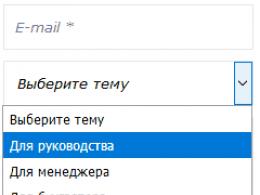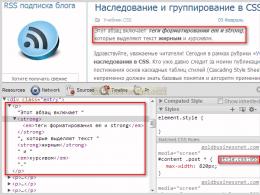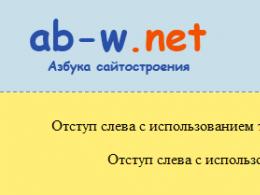Groups on social networks. Promotion of the group on social networks
Groups in in social networks are still an effective business promotion tool. With their help, they form a loyal audience, promote goods and services, and receive feedback from users. An alternative to groups is public pages of companies. They have less communication with subscribers and different rules of conduct. A company page can be created on any social network in the Russian Federation, a group can only be created on Facebook, Vkontakte and Odnoklassniki. We examined in detail the creation of groups on social networks: technical requirements, opportunities and limitations.
In contact with
Types of groups: open, closed and private. Any user can join open, group materials are in open access. IN closed group join at the invitation of the administrator or after approval of the application for membership. The materials are closed to users, but the group can be found through search. A private group cannot be found through search. The name, publications and participants will only be available after a personal invitation by the group administrator.
Group page called a wall. Adjust the status of the wall according to the group's goals:
- open - everyone can write and comment;
- closed - administrators and editors write, comments are prohibited;
- limited - administrators and editors write and comment on everything;
- off - the wall is not displayed, old entries are saved but not shown.
Group capabilities:
1. Custom cover. It displays the pinned post, group description and wiki menu.
2. Applications. Add apps to expand functionality. Users will be able to buy tickets or make an order without leaving the social network. VK offers a catalog of ready-made applications or you can make your own. There are 14 options for ready-made applications: poster, donations, food delivery, chat, movie tickets, vacancies, mailings, maps, wiki markup, appointment booking, online booking, event tickets, merchandise store and order status.
Print out stickers and place them in your store or office if the VK group is the main channel of communication with customers.
4. Broadcasts. Conduct live broadcasts to engage group members. For broadcasts via desktops, no additional equipment is required; for mobile broadcasts, use the VK Live application.
5. Online store. In the settings section, turn on the “Products” mode, a block with products will appear in the group. Fill out the product cards and select categories so that the products are displayed in the general VKontakte product catalog. Bulk upload products using the VK API. Create selections of products by category, collection, purpose, etc. Apply to include your group in the top store communities.
6. Export to Twitter. In groups with a closed or limited wall, it is possible to automatically export posts to one Twitter account. If a post is deleted from VK, it will also be deleted from Twitter.
Image requirements:
- Cover - 795x200px or 1590x400px;
- Product images - minimum length of one side - 400px, maximum - 7000px;
- avatar - one side - 200px, the other - from 300 to 500px;
- image for post - 510x510px;
- message with link - 537x240px.
Statistics. Detailed statistics are available for groups with 5000 or more members. Enable “advanced post statistics” to collect data. Information is collected from the last 150 posts of the group.
Types of groups: public, closed and secret. The settings are the same as in VKontakte.
Management. Two roles: administrator and moderator. The administrator has full rights. The moderator approves or rejects requests to join and publish, blocks participants, and deletes comments.
Possibilities:2. Selecting the group type. There are 16 options in total.

3. Groups in the “Sale and Purchase” category allow you to add products. Social Learning groups have modules with educational resources. The order of modules is determined by the administrator. It is possible to track how participants complete the modules.
4. Create photo albums, videos and events.
5. Business page. Bind official page company so that group members follow news and announcements.
Image requirements:
- cover for the group - 820x250px for the desktop version, 640x360px - for the mobile version, size - up to 8 MB, preferably extension - png;
- profile photo - 180x180px;
- image for the post - 1200x630px.
Classmates
Types of groups. There is only one type of community in Odnoklassniki - groups. They can be in eight options: public page, company, place, famous person or team, interest group, event, bulletin board, store. Select the type that best suits your business needs. If you need an official group, choose a public page or company; if you want to create a loyal audience, open a group based on interests.
Groups can be open, when any user sees the group’s publications, and closed, when users see posts only after joining. In the Manage section, select the members who can leave comments: everyone, members only, or no one. Enable the options “hide obscene language” and advertising in the feed. Prohibit or allow links to be left under posts in the group.
Management. There are two roles: administrator (super moderator) and moderator (editor). The first one appoints participants as moderators and has full rights to manage the group until it is deleted. The moderator serves the group, publishes and deletes posts, and works with statistics. There is also the status of an analyst - a participant only with access to group statistics.
Group capabilities:
1. Official status. Official groups are marked with a special icon and are displayed higher in the search results on the social network. To become official, submit a request in the Jira system form. At the same time, ask for a short name for the group. It will be handed over to the official group, even if it is occupied.
2. Design theme. Groups with more than 10 thousand members can create custom themes. Set the main image and cover the background with photographs to create a symmetrical design.
3. Built-in iFrame widget - a custom widget that automatically adds announcements of articles from your site. To activate, create an https page on the subdomain with the following parameters: fixed width - 608 px, maximum height - 430 px. Official media groups can use the widget for free, other groups can use it for a fee.

4. Bot. Create bots to monitor and respond to messages in group chats. Bots work based on Graph API methods.
5. Broadcasts. Live broadcasts are divided into two types: professional and streams. Create professional broadcasts in the “Live Broadcast” section. Shoot in HD quality, 1280x720 (16:9) resolution, fps above 24. We recommend using a camera and microphone. Set a start and end timer and record the broadcast if necessary. When the broadcast starts, all group members will receive a notification. To record a stream, you don’t need professional equipment, just the OK Live app. Broadcasting a stream to a group is possible under the account of an administrator or moderator.
6. OK-posting - a service for posting longreads. Maximum size post - 100 blocks.
7. Money transfers- option to receive payment to the group account. Bind bank card and set up transfer notifications.
8. Photo contests are a tool for conducting and automatically counting votes. To start, create a new album and select the photo competition type.
9. Applications. Using the designer, develop applications in the form of a test, newsletter, application or questionnaire.
10. The group catalog includes the best groups on the social network. Submit to the Directory if the group has unique content and new posts are added daily.
Image requirements:
- cover - 1340x320px;
- cover for the catalog theme - 240x90px;
- repeating page background - 320x320px;
- profile photo - 288x288px;
- image for post - 1680x1680px.
Statistics:
- review: engagement rate;
- users: growth and churn of participants, reach, reach by platform, engagement and Feedback, participants;
- actions: rendering content, joining a group, classes, comments, sharing, viewing photos, viewing posts, videos, music, links, deleting from the feed, complaining about content;
- publications;
- participants: number of participants, number of subscribers, gender, age, activity, geography, referral sources.
Remember
When creating groups on social networks, pay special attention to the name. A good name gives an understanding of what and for whom the group was created, and contains keywords for better indexing. Use the name of the organization if the group is being created for technical support users. If you want to gain a loyal audience, name it with your customers' interests in mind. A kitchen supplies store might call the group “Learning to Cook” or “Culinary Masterpieces,” or a children’s medical center might call it “Healthy Child.”
Do not add members to groups without their permission. Send no more than 30-50 invitations per day to friends to join the group, large quantity considered spam.
Take advantage of all the opportunities that social networks provide. Most additional settings and services from VKontakte group owners, least of all on Facebook.
For effective creation and promotion of the group in social networks analyze statistics of visits and audience engagement. Find posts that received the greatest response from participants and create similar ones. Separately track the negative reaction of users: hiding, complaints, negative comments.
The material was prepared by Svetlana Sirvida-Llorente.
Greetings to all my readers blog who came to find something useful. And so, as we know, social networks have recently gained great popularity and are constantly expanding and developing.
According to statisticians, our Internet users spend most of their time there, so it is not at all surprising that people began to use this tool to earn money.
Yes, that’s exactly how people make money in VKontakte, in Odnoklassniki, on Facebook and even on Twitter, but it’s not that simple. Damn, how disgusting it is when there is always one “BUT”. Of course, if we are talking about , it is important to understand that social networks have their own smaller tools that allow you to develop projects and earn money.
To begin with, I would really like to point out that there is a lot of money circulating in social networks. Information has appeared on the Internet that Pavel Durov, the founder of the VKontakte website, only officially earns from 50 thousand dollars a month, in addition, he has shares in the company, which also bring in money.
Next, an example with the famous young billionaire Zuckerberg, who in 2004, after launching Facebook, became a rich man. Why am I telling you this?? It’s very simple, I wrote these two examples, which you probably already knew, to show you the enormous scale of social networks.
Today, many schoolchildren, students, and what have you, adults, also use social networks. Such people need high-quality information and communication, and for webmasters this is an ideal option for earning money and promotion.
Look, you’ve created a new website or blog, no one knows about you, you haven’t made any progress on the Internet yet, where can you get new visitors?? Well, of course, from social networks, where there may be many of your potential clients.
Group: Think and grow rich.
Notes of a millionaire.
I wrote them for simple example, there are a lot of such communities on social networks. So why are they all being created, that people have nothing else to do?

In fact, such communities (groups, publics) have many functions:
— they allow you to develop your other projects (websites, blogs);
— In such communities you can offer your services, which means money and promotion of your own brand;
— communities often make real online stores of things and goods, so this is also not a bad option for getting money;
— communities allow you to earn money by advertising other projects and so on.
What can I say, if you have a group of at least 10,000 people, then you can already earn good money from it, I assure you.
The owners of such groups and communities earn about 500-1000 dollars daily, monthly earnings, you can calculate it yourself.
So, if you have already created your own group, but do not know how to promote it, then this article will help you.
And so, promoting any group, any community is a complex and time-consuming matter. I don’t want to focus my attention on those methods that involve money, but now there’s simply no way without it.
These are the main ways of promoting groups and publics that I know, if I miss something, write it in the comments, I will be only too glad. And so, let's now take a closer look at all these methods.
1. Well, well the most popular way is paid. That is, you find an already promoted group, a well-promoted public with over 100,000 subscribers. Next, you negotiate with the owner of the public or the admin to place paid advertising there.
Everybody pay the money, get ready beautiful picture and description, and, in principle, that’s all. If you do everything correctly, then for just 1000-1500 rubles you can get about a thousand subscribers to your community, which is not very bad.
2. If you don't like paying money, then there are still other options. For example, if your community already has several thousand people, then you can find the author of a group that has the same number of subscribers. You reach an agreement with such a person, that is, you place an advertisement for a friend and a friend.
The result is the following system: WIN – WIN. That is, you both benefit, since you will both receive new subscribers.
3.Promotion of your communities through websites and blogs assumes that on your resources you simply place advertisements for your community and promote it in this way. It’s not difficult, especially if you have a blog, then using a widget you can simply add a widget with your group, it’s very convenient. It turns out that you will have increased traffic on the community, as well as on the website, which people will access through the community.
4. It is known that The largest video hosting in the world is Youtube. This is quite a powerful toolkit, so to promote your communities you simply need to create your own videos that will contain links to your communities. Again, try to post interesting, funny, educational videos. People who watch your videos will also click on the links, which means they will subscribe to your communities.
5. Promotion of communities through applications. We all know that various applications are very popular now. My friends, for example, play “Indicot”, “Farm”, “Zaporozhye”, but the authors of these applications earn not only from themselves.
The authors of these applications also place various advertisements, for example, and others or their communities. This is quite relevant, because every day such applications are visited by millions of people, which means that a group or public can be promoted very quickly through the application.
Of course, everyone can’t become programmers, but you can, again, negotiate with the author of the application (at your discretion) to advertise your community with him.

6.Well, the last way to promote communities is application of one's own strengths and skills. For example, I am going to promote my community through many accounts to which I will add friends.
Meaning this method It’s very simple, you add friends every day, then you simply add these friends and subscribers to your communities. Is it difficult?? No, it’s not difficult, but it takes a lot of time, because you will need to constantly add friends and also enter a captcha. It is for such purposes that I would recommend that you use the VKBOT program. Very good program, which itself will add people and also send invitations to communities.
Here are all the methods that are known to me, if you know other ways to attract people to your groups, then write about it in the comments, I will definitely read them and, if anything, I will add to this article.
Promotion plan for your group for 2014:
- You will need to create 5-10 social media accounts.
- Every day, you will need to add people as friends to all these accounts.
- Then, you gradually begin to invite people to groups or public pages.
- From time to time, you order paid advertising in the communities you visit.
- Don’t forget that every day you need to send offers for mutual advertising to the authors of groups with the same attendance.
- A couple of times a week, upload videos (only your unique ones), make links to your community.
- You throw into your group only the most useful and necessary things.
If you devote at least 2 hours a day to this and approach it with due responsibility this case, then I assure you that the next New Year You will meet 2015 with a community of 30-50 thousand.
I will follow this algorithm, and you are with me?? Write, maybe you have other goals, write about it in the comments.
I’ll give you a couple more tips, try not to use the services of people who say that they can bring you several thousand people to the group in a day and it will cost, for example, 300 rubles. As a rule, such people simply increase traffic, and the people who visit your community are nothing more than ordinary robots.
After such robots subscribe to your community, their pages will be frozen by the site, after which there is a chance that your group may also get banned, do you need it??
Friends, if the post was useful to you, write about it in the comments, I’ll be waiting. I recommend that you subscribe to my blog updates, read my other articles. That's all for now, everyone.
Sincerely, Yuri Vatsenko!
Depending on your goals, you may have the following KPIs:
Goal: increasing awareness (company, brand, trademark, etc.)- The number of mentions of the company name, brand, trademark.
- Number of visitors, participants/subscribers of the community.
- Audience activity (number of comments, shares, likes, discussions).
- Number of queries in search engines.
- Number of followers.
- Number of brand advocates.
- Number of social activities.
- The degree of activity of discussions and discussions.
- Involvement of subscribers in participation in competitions, surveys, promotions.
- Number of users who made a repeat purchase.
- Audience coverage.
- Number of messages about the event.
- Number of users involved in support.
- Number of event participants;
- The number of requests for a product in search engines.
- Availability and quantity positive feedback, discussions, discussions.
- The ratio of positive and negative reviews about the product.
- Sales volume on social networks.
- Total sales volume of the product.
- The ratio of the number of hits via social media to the number of hits via traditional channels communications.
- Percentage of reach of current clients on social media.
- Amount of resources allocated for support.
Your project has a group on some social network, and maybe even more than one. But you don’t see any results from running a group, or you see very weak ones. What's the matter? But the point may be that at the stage of creating the group, you did not decide in advance what exactly it was needed for and what exactly you want to get in the end. They didn’t think through the concept of promoting their project on social networks. Let's look at what can be done to ensure that the group ceases to be “ballast” and finally begins to fulfill its functions.
Purpose of creating the group
At this stage, decide why the group is needed in general:
- to communicate with subscribers;
- to attract new clients;
- to increase brand awareness;
- for sales through a group;
- to increase traffic to the site.
All further work to promote the project on social networks is based on the goal. There may be more than one goal, but it is advisable to choose priority.
The target audience
We decided on the goal. Now the main thing is to find out for whom you are creating a group, that is, to identify the target audience so as not to work “with your eyes closed.”
To promote on social networks, it is important to draw up not just a portrait of a typical representative of your audience, but also write down which social networks he uses most often and where he communicates. It is useless to wait for visitors on a Facebook page if they spend most of their time on VKontakte and Instagram. Thus, traditionally, VKontakte and Odnoklassniki are preferred for women’s topics and family topics, Facebook is more suitable for business and education, and for niches where there is a lot of photo content and clients “buy with their eyes,” Instagram is ideal.
Once you find out where typical representatives spend most of their time, create a group or community there. It is not necessary to maintain communities on all social networks; it is enough to be present where your target audience spends time.
Competitor analysis
Competitor analysis will help you choose positioning:
- What social networks are you present on?
- How many members are in the communities?
- Topic of content sections?
- How often are they updated?
- Activity among participants?
- Are there promotions and competitions?
After the analysis, think about where you can profitably build. There may be several options.
- Offer solutions to problems or acquisition of additional benefits.
- Describe the differences.
- Create an association image with the project.
- Write down situations in which only your product will help.
Choose the most striking characteristic - that will be it the main idea of the community.
Let's say you have a project on educational activities for children. You can offer mothers:
- ready-made scenarios for classes or a choice of several templates dedicated to one topic;
- developing certain skills in children in one area, for example, learning to read;
- development for children of a certain age, gender or temperament;
- a fictitious character in whose name classes with children will be held.
Here, for example, are the avatars of groups representing children's development centers in a social network in one city. They are all competitors, but each center has its own feature that distinguishes them from others:
Groups of development centers in one region
And for a project with the sale of goods (clothing, toys, etc.), we choose positioning:
- according to the situation of use (casual or formal wear);
- by price (affordable to everyone, for the middle class, luxury goods);
- on the quality of goods;
- by assortment.
Group registration
In order for community visitors to associate with your project, you need to think through visual design. In the group, the following are responsible for visual perception: an avatar, a menu, a template for posts and photo album covers. If you have a website, design the group in the same style as the website, that is, using the same colors and the same images.

When the group avatar reflects the positioning, this is the best option. If we teach children to read, then a child with a book will look great. And when we sell casual children's clothing, we put children in similar clothes on their avatars.
For professional group design, contact a designer.
Content
On social networks, content is updated frequently: from 1-2 to 20-30 posts are published during the day. To make it interesting for the visitor to participate in the community, try to select a variety of material. Create thematic sections and decide what type of posts you will publish in each of them. It is also advisable to create a separate section for positioning the project.
Options could be:
- Project information: history of creation, why, to whom it is useful, contacts, information for beginners, trainers (teachers, management), specifics of work, reviews, events, and so on.
- Common topics that the project reveals: various methods, techniques, practices, books, magazines, reviews, videos, audio recordings, famous personalities on the topic of the project, quotes, event announcements, and so on. For example, an early development project can publish teaching methods, the results of using these methods, introduce new books, review educational games and toys, and offer ideas for classes.
Here is an example of an unsuccessfully chosen topic that the group’s target audience did not appreciate:

A post about children's activities is not entirely suitable for a gastronomic group
But here are examples from the same group with posts on the “correct” topic:

In a group about food, posts about food look quite organic :)
- Topics close to the project. For example, let’s take the same development of children. If practiced general development child, then you can cover topics of emotional, musical or physical development.
- Universal themes. Useful selections, humor and holiday greetings.
- Calls to action. Posts that involve feedback from the visitor: polls, tasks to come up with a caption for a photo, leave a review, ask a question, invite to discussions. This also includes competitions and sweepstakes.
Come up with titles for the columns and create a schedule indicating on what days and at what time a certain column is published. Create an example post for each category. And... work according to plan.
Promotion
You’ve decided on the goal, registered your target audience, chosen positioning, formed a group and publish interesting posts... But for some reason people don’t join. Or they join, but not enough. What needs to be done to promote the group?
It’s not enough to just create a group; you need to take care of its promotion. Tell people about the project and invite them to join.
To promote groups, they use the following promotion channels:
- Sowing in communities- this is when a post is posted in other groups of related topics and a link is given to go to your group.
- Targeted advertising- with the ability to display advertising to a specific target audience. Geography, gender, age, interests of the target audience, and so on are selected.
- Publications from opinion leaders- agree with the opinion leader that he will make a mention or review of a specific project (service, product) for his subscribers.
These are “white” promotion methods. They require a certain budget. But the result when used is more significant than when promoted in dubious ways.
After using each promotion channel, it is important to do an analysis. How much money was invested, the number of transitions to the group, the number of entries, how much a new member cost, the conversion from visitors to subscribers, and so on.
To promote online, it is not enough to simply create a group and post thematic content. Promoting a group is a serious job that includes many nuances.
Now you have a small work plan that will help you figure out what to implement and in what sequence. And if some were missed important step When creating and promoting a community, try to analyze and eliminate shortcomings.
The process of creating groups on social networks
In fact, it is incredibly simple: even a schoolchild can create a group on any social network, spending no more than 5 minutes on it. But when we talk about communities that will solve certain problems, the process becomes significantly more complicated. Surprisingly, even here you can’t do without analytics: in the first stages of creation, it is extremely important to place the group in the niche where it is most likely to develop successfully.
- Analysis target audience and competition, identifying a promising niche;
- Community design and menu development;
- Uploading content, setting up functionality;
- Formation of a content plan and editorial policy (if necessary);
- Preparation of basic content for the group (if necessary).
When creating a community on social networks, it is important to take into account all the nuances and little things that, in a highly competitive environment, can be the determining criterion for choosing the target audience between you and other thematic communities. To be original, while maintaining adequacy and a rational core - this is the task of communities on social networks striving for success and solving the problems assigned to them.
The cost of creating groups (Vkontakte, Facebook) is from 15,000 rubles.
Deadlines – 10 days.
Why you should entrust the creation of a group on social networks to O`Es:
- Work on the basis of a proven strategy, setting and achieving goals, solving problems;
- Powerful research work – 50% of community success;
- Creative, attractive design, development of group usability;
- A bunch of additional services– from content preparation to maintenance and filling;
- Creation of modern communities with a pronounced individual content.
Groups created by O`Es specialists are communities that can become successful in a short time. Beat your competitors even at the stage of creating a group -
entrust the process to professionals!






